How to Get Started Playing Ukulele
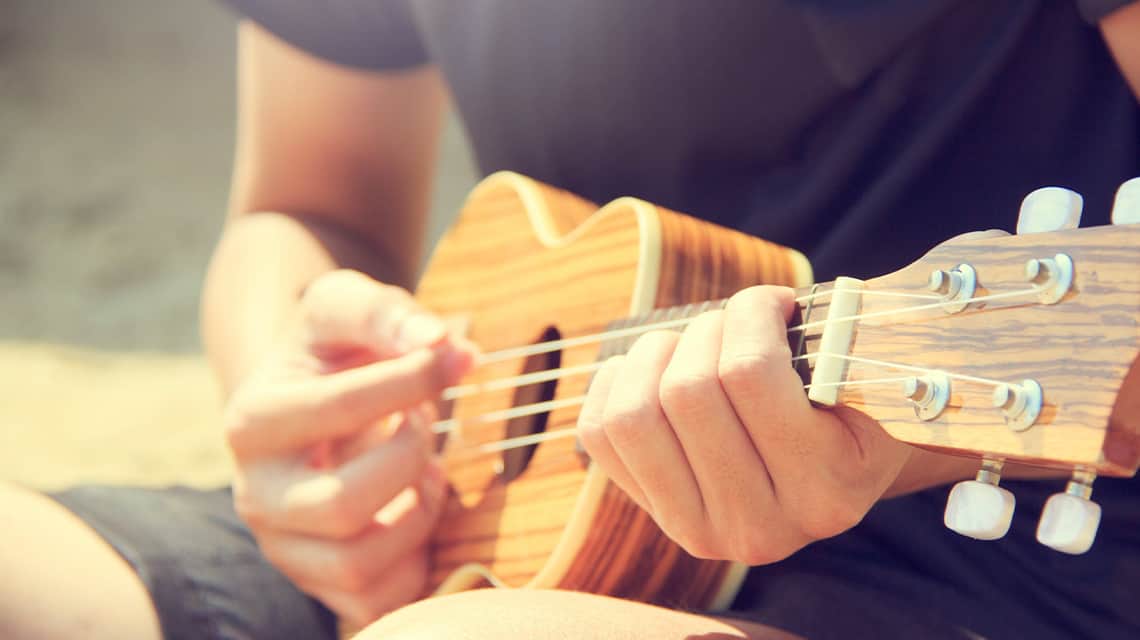
If you need more music in your life, and you probably do, get a ukulele or dust off the one sitting on your shelf and start playing! Playing the ukulele is so fun and satisfying, and it’s simpler than you think. If you’re trained in another area of music, you’ll enjoy the casual, laid-back expectations that come with the ukulele. If you’ve never played an instrument before, the ukulele is a good entry point for getting started right away without extensive training. Here’s what you need to know before you get started:
Getting A Ukulele
Ukuleles are easy to find online or in music shops. As with most instruments, buying the very cheapest option probably isn’t the best idea. Though you can find ukuleles for $20-$30 USD, they will likely be of lower quality, breaking easily and not holding pitch well. But, just a step up brings you to the $40-$50 USD range, which is still really affordable, and will allow you to get a decent instrument.
Ukuleles come in 4 sizes: Soprano, Concert, Tenor and Baritone.
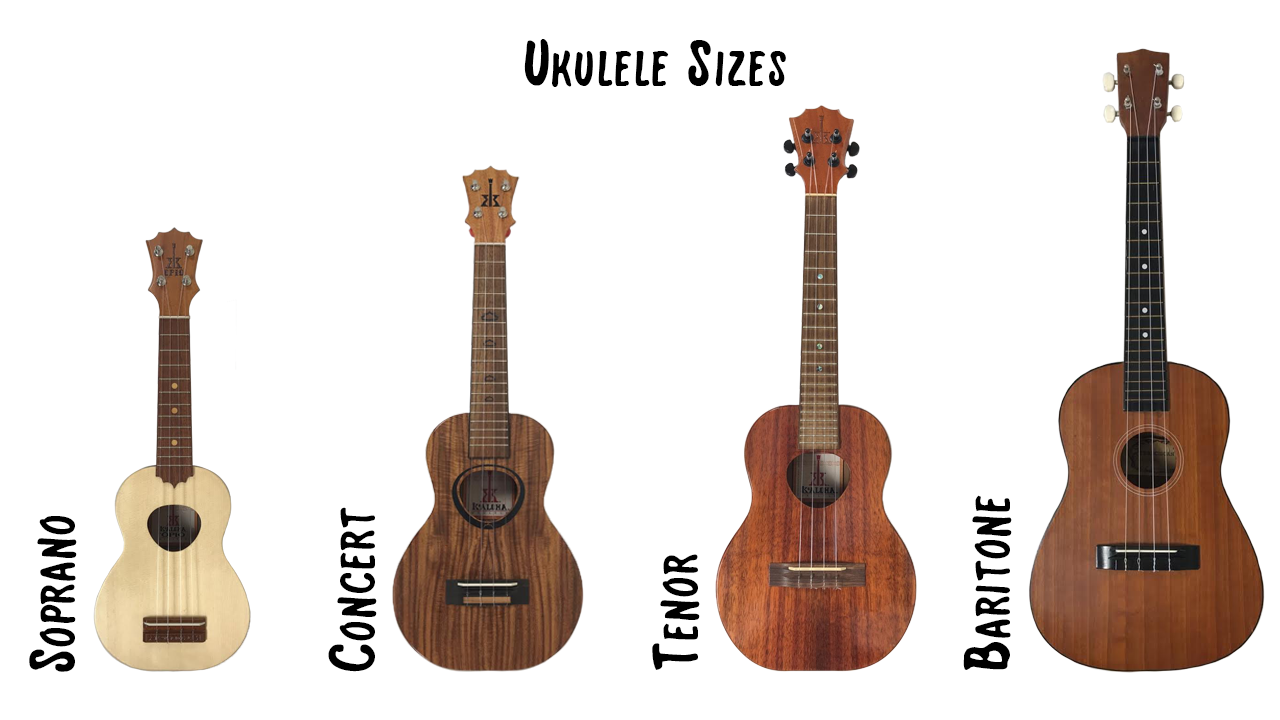
Image from https://www.ukulelemusicinfo.com/blog/ukulele-sizes/.
Soprano ukuleles are the smallest and most common ukuleles. Most people start with this size and upgrade later once they are hooked on playing. There are several brands available for right around $50 that all have a good reputation of being reliable for beginners. Their small size makes them very portable and easy to work with. Click here to browse soprano ukuleles.
A concert ukulele plays precisely like a soprano, but it’s a little bit bigger. If you have bigger hands, you might like having a bit more space with the concert size. They are a little more expensive, but still very affordable, starting at around $100. Click here to browse concert ukuleles.
The next size up is a tenor ukulele. It is still similar to the soprano and concert in that it is tuned the same way, but it’s larger size gives it a fuller and bigger sound. Click here to browse tenor ukuleles.
A baritone ukulele is the largest and is tuned differently than all of the other ukulele sizes. They have a deeper sound that almost resembles a guitar. Click here to browse baritone ukuleles.
Be careful; ukuleles can be fun to collect because they come in many different colors, with exciting designs and patterns on them. Most people can’t buy just one!
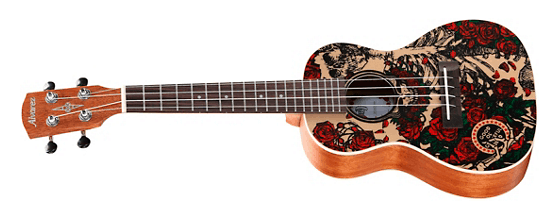
Alvarez Grateful Dead Concert Ukulele
Note: If you’re left-handed, you have the option of playing a ukulele as-is, or, some lefties flip their ukulele to the other side and have its strings placed in the opposite order. The rest of this article is written assuming you’ll be holding the ukulele in the standard position, but you can adapt it if you need to. If you search for left-hand ukuleles, you’ll find some useful articles explaining how to switch them around.
How It Works
When you get your ukulele, you’ll want to tune it right away, in addition to planning on regular tuning. If you purchase your ukulele at a music store, you can probably get it tuned before you leave. If you buy it online, you’ll have to do it yourself. It’s not hard, but make sure you do some research or enlist in some help, so you don’t break a string.
There are four strings on a ukulele. Hold the ukulele like you would a guitar. Your left hand will hold the neck of the ukulele where all of the strings are. The body, the largest part of the ukulele, will rest against your body, and your right hand will hover over the strings in the vicinity of the sound hole.
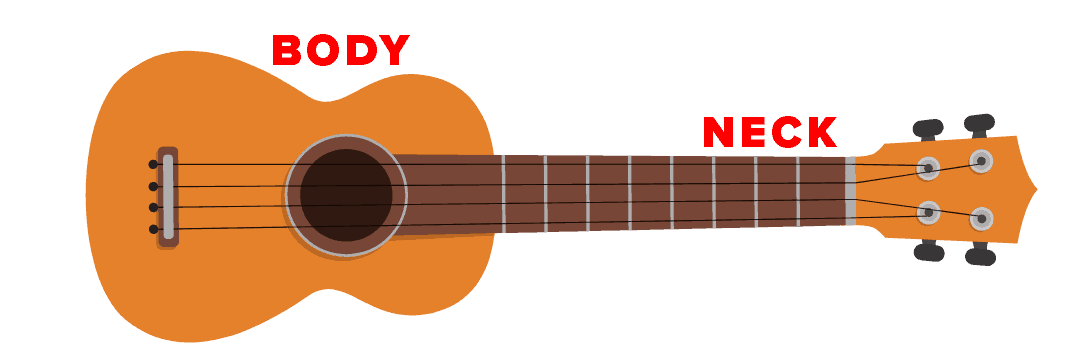
When holding the ukulele in this position, the string at the top, closest to your face, will sound as a G. Moving down, the next string is C, followed by E and A.
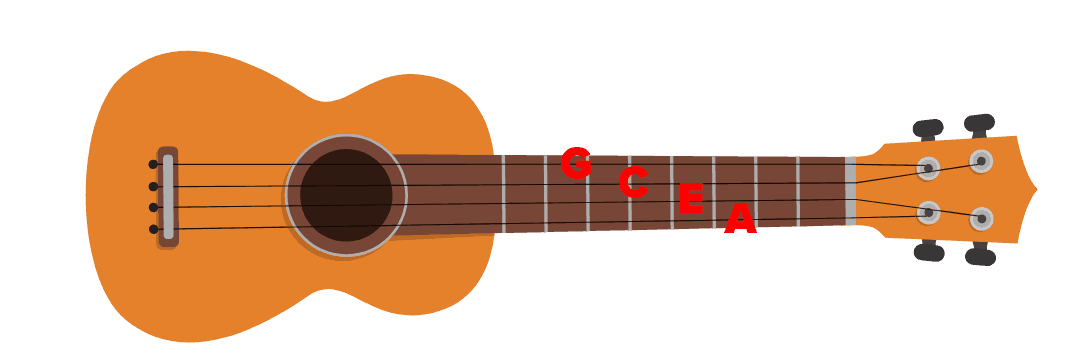
Unlike many stringed instruments, these pitches do not sound from low to high. Instead, the G is higher, C is the lowest, then E and A are higher again. Check out this video to hear what the notes sound like when played in tune.
To tune the strings on your own, you’ll probably need an electric tuner. You can buy a small tuner that will attach to your ukulele or use an app on your phone.
One thing that’s a little unusual about the ukulele is that the G and C strings are strung in one direction and the E and A are strung in the opposite. This means that when you’re tuning, you move the pegs for G and C clockwise to lower the pitch and counterclockwise to raise it. However, E and A are the opposite of this: turn the peg clockwise to raise the pitch and counterclockwise to lower it.
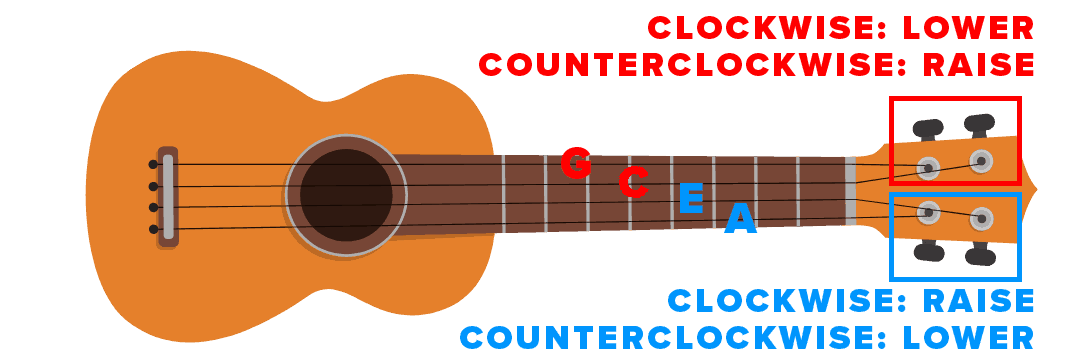
When you tune, go slowly. It takes time to learn how much to turn the peg to change the pitch. If you turn it too quickly, it’s easy to over tune and break a string. The strings of a ukulele are strung tightly, but not so tight that the strings can’t move from side to side when you pluck them.
- If your tuner is reading a note as a flat (♭), it means you need to tune higher.
- If you see a sharp sign (#) it means you need to lower the pitch.
If your ukulele is new or hasn’t been tuned in a while, it may have trouble holding the correct pitches. Ukulele strings stretch, kind of like a rubber band. When the strings are tightened in place, they will want to return to their unstretched position. The result is a ukulele that sounds flat. Tuning your instrument frequently will help the strings maintain the stretch they need to hold the correct pitch.
Don’t be frustrated if you have to tune many times in your first practice session. If you keep tuning your ukulele daily, it will soon start staying in tune more consistently.
How To Start Playing
On the ukulele, you can learn to play individual notes or chords. Most people learn chords because once you learn a handful of chords, you’ll be able to play a lot of songs. Also, playing with chords makes it easy to sing along while you play! But, it’s worth it to learn to play individual notes so that you can find melodies, play fun riffs, and play songs with fingerpicking patterns.
-
- Chords
The first 4 chords that you’ll want to learn on the ukulele are C Major, A Minor, F Major, and G Major. These 4 chords can be used in hundreds of songs.
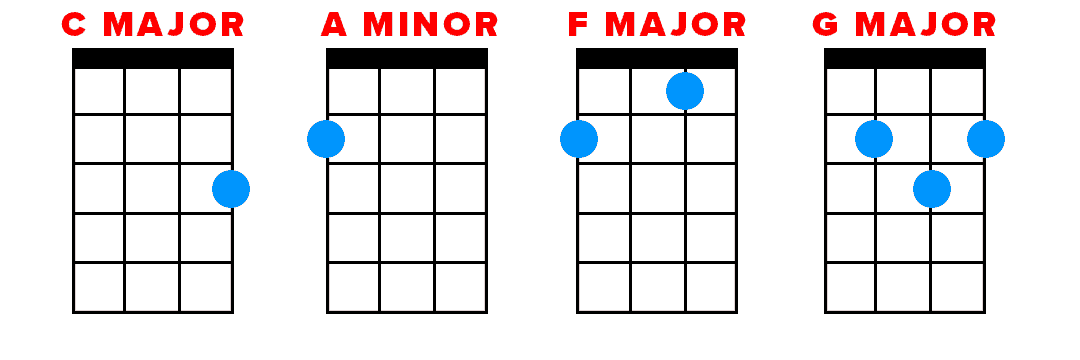
The C Major and A Minor chords are super easy because they only require one finger on a string. For F Major and G Major, you’ll need to place 2 or 3 fingers on different strings. Once you learn how to position your fingers for these 4 chords, practice moving between all of the different chords slowly. A great resource to learn hand positions for these chords is ukulele-chords.com. Click each of the chords below to learn how to play them.
Here are some simple patterns (or chord progressions) to repeat over and over to get used to moving between chords:
- C-a-C-a
- C-a-F-C
- C-G-C-G
- C-a-F-G
Focus only on the hand positions at first, and once you are comfortable, move on to strumming the chords.
-
- Strumming
While your left hand is forming chords, your right hand is in charge of strumming to keep the rhythm and the music moving.
You can strum with a pick, with your thumb, or with 2-3 fingers. Strumming downwards is the most common and gives you the strongest sound. When you’re first starting, practice playing chords for 4 counts at a time. You could do this two ways:
- Strum downward one time on a chord, count to 4 at a steady pace, then move to another chord for 4 counts. This is an excellent way to practice moving between chords. As you’re counting the 4 counts, start preparing your hand to make the chord change. Plan which fingers are going to have to move and see if you can make the switch as quickly and gracefully as possible.
- If you’re ready to take it to the next level, count to 4 while strumming with each count. Do 4 down strums in a row on the same chord before switching to the next chord. Make sure your strums are evenly spaced and steady. Once again, as you are counting the 4 strums, be mentally moving ahead to the next chord to help yourself get there quickly.
This is a useful approach to practice for a while as you master your first 4 chords. And once you feel good about moving between chords and strumming downwards, you can play around with adding a few up strums in the mix. Up strums add interesting textures and rhythm emphasis to your music.
At first, practice a consistent down-up-down-up pattern at a steady beat. As you’re ready, you can learn more complex strum patterns and incorporate them into your playing.
A lot of times, strum patterns are abbreviated with D for down and U for up. You might see something like this at the beginning of a song:
D-U-D-U-D-U-D-U
This would be the steady down up pattern we just mentioned. However, a more complicated pattern would look like this:
D—D-U—U-D-U
This strum pattern is really common and sometimes called an island strum. Those longer lines would indicate that those strums are held a little longer than the others. For something like this, you’d want to practice the pattern over and over on just one chord or open strings as you learn it. Learning a strum pattern can take a lot of coordination, and sometimes you’ll have to rely on muscle memory once you add a chord progression and possibly singing to the mix. Check out this ukulele strumming video for an in-depth demonstration of everything we’ve just covered!
Take your time learning new strum patterns and start incorporating them into songs as you’re ready.
-
- Singing
One of the draws to the ukulele is that it’s an easy instrument to sing along with. If you’re not into singing, don’t worry; you don’t have to sing to have fun playing the ukulele. But, if you’d like to belt out your favorite tunes as you play, you’ve made a great choice by learning the ukulele!
Some people find that it’s hard to coordinate their left-hand chords, plus right-hand strumming, in addition to singing. It can be hard to put all of these components together. Just remember that you have to work on each of those skills independently, and over time they will come together.
It can be tricky when the vocal line doesn’t match up very well with the strum pattern. It’s okay to simplify your strumming to all downs or a steady down-up pattern while you get comfortable singing along.
How To Practice
Before you know it, you’ll be ready to start playing some real music. There are tons of great resources around to help you practice.
-
- Play-Along Videos
One fun way to practice is to search for ukulele play-along videos on YouTube. They’re kind of like ukulele karaoke. You’ll see lyrics and chord changes on the screen so that you can play with the video. These are a great way to learn to play with accurate timing. If you have trouble keeping up, simplify your strumming. Just strum one time per chord, and don’t worry if you miss chords. If certain chords give you trouble, just jump over them all together and go back and practice them later. Here’s an easy ukulele tutorial for “The Lion Sleeps Tonight” with only 3 chords!
Spend some time away from the video working on the tricky chord changes and over time; you’ll be able to play all of them. A considerable advantage of play-along videos is that they’re forcing you to play with good continuity and to keep the music going. This is something that usually doesn’t happen independently in practice, so it’s helpful to have a way to enforce it.
-
- Apps
There are a lot of helpful apps for learning the ukulele. Yousician is very interactive and uses the microphone of your device to respond to your playing. It’s almost like having a teacher with you!
Ukulele Toolkit is another great app, with several helpful features such as strum patterns, chord charts, and play-along drum loops.
Ukulele Karaoke is similar to playing along with YouTube videos, except it’s a little more interactive. The lyrics do appear on the screen; however, you’ll hear an instrument playing the melody instead of a voice, so it doesn’t sound quite as authentic as a real singer in a YouTube video.
There are tons of other great apps out there. Search around a bit and try a few to find the best one to suit your needs.
-
- Jam With Friends
The very best way to improve your ukulele skills is to play with other musicians. Playing along with others helps you respond and adapt on the spot. This is invaluable music training!
Some communities have ukulele clubs or groups that get together regularly in a public place to jam. If there’s one in your area, check it out! Ukulele fans are super friendly by nature, laid-back, and welcoming. Even if you have minimal ukulele skills, they’ll help you fit right in.
If your area doesn’t have a group, try to find a friend or family member to play along with. Guitars and ukuleles work well together, so if you know someone who plays the guitar, see if they’ll jam with you. Ukuleles also make nice accompaniments to melodic instruments like violins, flutes, or recorders. Let your buddy play the melody and see if you can play along.
We hope you’re now ready to take on the ukulele! As you’re beginning to learn this beautiful instrument, you’ll probably want to play a bunch of different songs, so don’t forget to grab some of the best ukulele sheet music at musicnotes.com. Whether you want to learn a classic, like “Here Comes the Sun” by The Beatles or take on the “Old Town Road” by Lil Nas X, check out our extensive ukelele catalog here.

